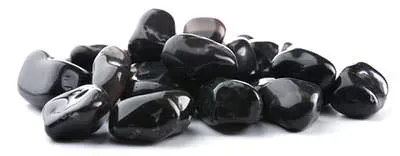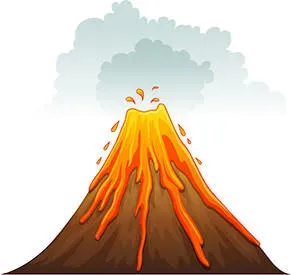 Onyx is the birthstone for Leos and the anniversary gemstone for the 7th year of marriage. Black Onyx is the anniversary gemstone for the 10th year of marriage. Onyx is a variety of the microcrystalline
Onyx is the birthstone for Leos and the anniversary gemstone for the 7th year of marriage. Black Onyx is the anniversary gemstone for the 10th year of marriage. Onyx is a variety of the microcrystalline ![]() quartz, called
quartz, called ![]() chalcedony. The name "chalcedony"" comes from Calcedon or Calchedon, an ancient port on the Sea of Marmara in Asia Minor. Ornamental materials were once mined in that area and it was an active center for trading various stones. Onyx were used widely in the past as bases and handles for gold items, as well as for stone inlay work. Onyx seals were very popular with the Romans, who carved the pattern of the seal in negative relief to give a raised point. They often used stones with several layers, each of a different color, which were then individually carved to produce a different pattern each year. They originally used the onyx name for a variety of marble having white and yellow veins. Onyx is the Greek word for ""claw"" or ""fingernail"" because these veins resemble the colors of a fingernail. The marble is still called ""onyx marble,"" being less valuable and softer than onyx which has a hardness rating of 7. Onyx was also traditionally used for carving cameo brooches."
chalcedony. The name "chalcedony"" comes from Calcedon or Calchedon, an ancient port on the Sea of Marmara in Asia Minor. Ornamental materials were once mined in that area and it was an active center for trading various stones. Onyx were used widely in the past as bases and handles for gold items, as well as for stone inlay work. Onyx seals were very popular with the Romans, who carved the pattern of the seal in negative relief to give a raised point. They often used stones with several layers, each of a different color, which were then individually carved to produce a different pattern each year. They originally used the onyx name for a variety of marble having white and yellow veins. Onyx is the Greek word for ""claw"" or ""fingernail"" because these veins resemble the colors of a fingernail. The marble is still called ""onyx marble,"" being less valuable and softer than onyx which has a hardness rating of 7. Onyx was also traditionally used for carving cameo brooches."
 The myth of the origin of onyx says that the goddess Venus was resting on the banks of the Indus River. As she slept, Cupid used the point of one of his enchanted arrows to give her a manicure. The parings of her nails then fell into the waters of the sacred river. Since the nails were of heavenly origin, they sank to the river bottom and were metamorphosed into onyx.
The myth of the origin of onyx says that the goddess Venus was resting on the banks of the Indus River. As she slept, Cupid used the point of one of his enchanted arrows to give her a manicure. The parings of her nails then fell into the waters of the sacred river. Since the nails were of heavenly origin, they sank to the river bottom and were metamorphosed into onyx.
 Onyx is a protective stone worn when facing adversaries in battles of conflicts of all kinds, or while hurrying down a dark street late at night. In classical ceremonial magic, the image of the head of the god Mars or a figure of the hero Hercules was engraved on onyx and carried for courage. Indians and Persians believed that wearing onyx protected them from the evil eye, and that placing onyx on the stomach of a pregnant woman in labor would reduce the labor pain and bring on earlier delivery.
Onyx is a protective stone worn when facing adversaries in battles of conflicts of all kinds, or while hurrying down a dark street late at night. In classical ceremonial magic, the image of the head of the god Mars or a figure of the hero Hercules was engraved on onyx and carried for courage. Indians and Persians believed that wearing onyx protected them from the evil eye, and that placing onyx on the stomach of a pregnant woman in labor would reduce the labor pain and bring on earlier delivery.
 Onyx is not only used for protection, but also as defense against negativity consciously directed towards you. It has also been used to reduce uncontrollable sexual impulses. The close union and yet strong contrast between the layers of black and white in some varities of onyx may suggest its connection with romance. In India, Gemologists recommend Onyx as a protective measure for harmonious relationships, thus keeping away any probability of disturbances or differences between the couple. Onyx as a birthstone provides the structure and authority you crave. It can help you be the master of your destiny and strengthen your confidence. It provides support in difficult times and centers your energy in times of mental or physical stress. It also offers the gift of wise decisions.
Onyx is not only used for protection, but also as defense against negativity consciously directed towards you. It has also been used to reduce uncontrollable sexual impulses. The close union and yet strong contrast between the layers of black and white in some varities of onyx may suggest its connection with romance. In India, Gemologists recommend Onyx as a protective measure for harmonious relationships, thus keeping away any probability of disturbances or differences between the couple. Onyx as a birthstone provides the structure and authority you crave. It can help you be the master of your destiny and strengthen your confidence. It provides support in difficult times and centers your energy in times of mental or physical stress. It also offers the gift of wise decisions.
 Throughout history, onyx has been thought to bring powers of protection, defensive magic, and the reduction of sexual desires. It has also been thought to reinforce the knowledge that there is no death, aiding in the understanding of the wheel of birth, death and rebirth. It brings about the knowledge that separation is an illusion and reunion will come. It aids psychic contact with those who have died, facilitates s�ances and mediumship, brings messages from the dead, and aids past-life and between-lives regression work. It helps future life progressions, and prevents and removes spirit possessions.
Throughout history, onyx has been thought to bring powers of protection, defensive magic, and the reduction of sexual desires. It has also been thought to reinforce the knowledge that there is no death, aiding in the understanding of the wheel of birth, death and rebirth. It brings about the knowledge that separation is an illusion and reunion will come. It aids psychic contact with those who have died, facilitates s�ances and mediumship, brings messages from the dead, and aids past-life and between-lives regression work. It helps future life progressions, and prevents and removes spirit possessions.
 Contemporary authors say the onyx brings increased vigor, strength, stamina, and self control. It alleviates worry, tension, and nervousness and eliminates confusion and nightmares. It is used to provide glimpses of that which is ムbeyond' and activates one's memory of one's roots and reality. Medicinal applications include the treatment of bone marrow diseases, teeth, foot, blood and bone problems, and soft tissue disorders. It is also believed to aid in ailments such as epilepsy or glaucoma and is known to have powers to rectify damage done to cells.
Contemporary authors say the onyx brings increased vigor, strength, stamina, and self control. It alleviates worry, tension, and nervousness and eliminates confusion and nightmares. It is used to provide glimpses of that which is ムbeyond' and activates one's memory of one's roots and reality. Medicinal applications include the treatment of bone marrow diseases, teeth, foot, blood and bone problems, and soft tissue disorders. It is also believed to aid in ailments such as epilepsy or glaucoma and is known to have powers to rectify damage done to cells.
 Onyx is formed by the deposition of silica in gas cavities in lava, which results in the distinctive bands or stripes we see in the stone. They come in varied shades of red, orange, and brown, which often alternate with striking bands of white. The banding in onyx is straight, and is either brown or black and white, while curved bands occur in the variety of
Onyx is formed by the deposition of silica in gas cavities in lava, which results in the distinctive bands or stripes we see in the stone. They come in varied shades of red, orange, and brown, which often alternate with striking bands of white. The banding in onyx is straight, and is either brown or black and white, while curved bands occur in the variety of ![]() quartz known as
quartz known as ![]() agate. Since ancient Egyptian times, onyx has been stained to improve or change its color. Natural black onyx is rare, so the commercial black variety is usually agate that has been stained by the sugar-sulfuric acid treatment, soaked in sugar and then heated in sulfuric acid to carbonize the sugar. It may be banded or solid black.
agate. Since ancient Egyptian times, onyx has been stained to improve or change its color. Natural black onyx is rare, so the commercial black variety is usually agate that has been stained by the sugar-sulfuric acid treatment, soaked in sugar and then heated in sulfuric acid to carbonize the sugar. It may be banded or solid black.
 Onyx can be found in Uruguay and bordering regions of Brazil, Afghanistan, India, Madagascar, Peru and the US. Baja California, and northwest Mexico were a major source for onyx until cheap imitations appeared on the market.
Onyx can be found in Uruguay and bordering regions of Brazil, Afghanistan, India, Madagascar, Peru and the US. Baja California, and northwest Mexico were a major source for onyx until cheap imitations appeared on the market.
 The best way to clean an onyx is to wipe it clean with a moist cloth. It is not recommended to use any sort of ultrasonic cleaners or ammonia as the stones may be porous and therefore might absorb chemicals, even soap, which can build up inside the stone, causing discoloration.
The best way to clean an onyx is to wipe it clean with a moist cloth. It is not recommended to use any sort of ultrasonic cleaners or ammonia as the stones may be porous and therefore might absorb chemicals, even soap, which can build up inside the stone, causing discoloration.